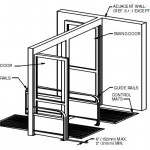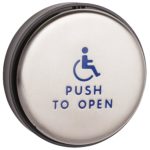Every so often I ask the readers of iDigHardware to weigh in on what you are seeing in your state or local jurisdiction. Today I need your help on the topic of accessibility symbols – please share your insight in the comments.
In your jurisdiction, which of the following applies to actuators for automatic operators?
-
The International Symbol of Accessibility (ISA) is required on the actuator
-
The Dynamic Symbol of Accessibility (DSA) is required on the actuator
-
Either symbol may be used on the actuator
-
A custom symbol may be used on the actuator
-
No accessibility symbol is required on actuators
If you are not familiar with the two most common symbols of accessibility, the ISA has been around since at least the 1960’s, and is the symbol that is currently referenced in the ADA Standards for Accessible Design. About 10 years ago, a movement began to update the symbol to the Dynamic Symbol of Accessibility (DSA), which places more emphasis on the person than on the wheelchair, and shows movement, a symbolic action that reframes the way society views and interacts with people with disabilities.
Some states and local jurisdictions have already passed laws changing required signage from the ISA to the DSA – you can read more about that in my past post from 2017.
The ADA Standards for Accessible Design require the ISA to be posted in certain locations, including:
- Portable toilet units and bathing units that comply with 603 (213.2(3))
- Entrances that comply with 404 – in facilities where not all entrances are compliant (216.6)
- Elevators that comply with 407 – in facilities where not all elevators are compliant (216.7)
- Toilet rooms and bathing rooms that comply with 603 – in facilities where not all of the rooms are compliant (216.8)
- Check-out aisles complying with 904.3 (216.11)
- Parking space identification signs (502.6)
I checked in with the US Access Board last week, to see if there had been any changes affecting these symbols. In locations where the ADA standards require the ISA (a parking sign, for example), equivalent facilitation would be required in order to use the DSA instead of the ISA. This requires a waiver from the agency implementing the standards. For example, the State of New York has passed a law requiring the dynamic symbol instead of the ISA:
Accessibility Legislation A.8193 and S.6846: Requires the office of temporary and disability assistance to promulgate any rules and regulations necessary to remove the word handicapped from any signs or means of communication where such word appears; further requires that anywhere where it is required that the current universal symbol of access of figure in a wheelchair appear that such signage instead depict a logo with a dynamic character leaning forward with a sense of movement; applies only to new signs.
The New York law requires the DSA, but the law is specific to signage. The ADA standards require the ISA in certain locations, but actuators for automatic operators are not one of the locations referenced in the standard. Are either of these symbols required on actuators? I looked into this a couple of years ago when many actuators were changed to touchless switches that did not have an accessibility symbol – that post is here. The only state code I found that requires a specific symbol (the ISA) on actuators is California.
I double-checked with the US Access Board, and confirmed that if an accessibility symbol is not required by the ADA standards in a particular location – like an actuator – any symbol (or no symbol) may be used in that application.
What are you seeing locally? Are actuators for automatic operators required to have the ISA, the DSA, either symbol, or no symbol? Or could a “custom” symbol be used?
WWYD?
You need to login or register to bookmark/favorite this content.









Very interesting! In Florida the ISA symbol is used and the ISA symbol is referenced in the Florida Accessibility Code for Building Construction.
Hi Mason –
I think Florida uses the ADA standards, so the locations that I referenced in the post would be the locations where the ISA is required. Have you seen anything that specifically references the symbol on actuators in Florida?
– Lori
From my experience, the ISA or DSA symbol is not required in the NW on actuators that are located on a public or resident accessible entry. I still specify actuators with the ISA symbol at these locations because I believe it’s the right thing to do, much like signage on a parking space. Auto operated doors which are used for convenience reasons (such as a hospital corridor gurney path) are not required to have any symbol and I rarely specify any symbols at those locations (and most of those are going with touchless actuators now).
Thanks Joe –
It’s interesting that you are choosing whether to use an actuator with a symbol or without based on the location of the door. I wonder if that is a common strategy among specifiers.
– Lori
The symbol I see in Wi is the Black one in the article….the person sitting upright in the wheel chair. The blue symbol with the person leaning forward looks like it would be used to mark the starting line for a wheelchair race.
Paul
Thanks Paul –
The black one is the International Symbol of Accessibility – the one that is required by the ADA standards for specific signage. Are you seeing a requirement for this symbol on actuators?
– Lori
California boy here! I can confirm that we always spec the ISA symbol on actuators to be within compliance. We usually spec most touchless actuators with the ISA on it which seems to be a heavily California influenced design. As previously noted in one of your articles, the common field application of the CBC seems to point to exterior openings being the main focus for the ISA symbols, but you can never be too safe with your specs out here!
I agree, Darren – California is pretty clear. So far it’s still the only state where I have seen the the requirement for the ISA on actuators.
– Lori
I have a strong opinion about this micro-issue: people who use wheelchairs to move about in the built environment are not passive people. Knowing that life-follows-art-follows-life, I find the traditional ISA artwork very subtly dismissive if not degrading; I specify the dynamic symbol every time and argue for it. I’ve only been compelled to back down with California state-funded projects that require review by the state’s Division of the State Architect (the DSA, ironically). They simply state that it’s not approved, and there’s no argument — they hold the purse strings. So, on this tiny issue, I’ll deliberately specify a “code violation”, let them redline it.
I contend that people navigating architecture via wheelchair are not at all confused by the dynamic symbol. Perhaps, they’re even subtly encouraged.
Hoping some people reading your marvelous column and who use wheelchairs will chime in.
Thanks for sharing your insight, Tom!
– Lori
Perhaps there should be different icons for different forms of mobility impairment. Some people may be able to ascend or descend individual steps, but have difficulty traveling great distances. Others may have difficulty with distance, but would be unable to take any kind of step. Some people may be able to safely ascend or descend a moderately steep ramp that was designed for cars, while others would have no ability to do so.
To my mind, the DSA may be appropriate to indicate that facilities are suitable for use by people with moderate mobility limitations, but not necessarily suitable for use by people with more severe limitations, though it’s ambiguous as to what degree of mobility would be required to use the facilities.
In MA where AAB (521 CMR) applies, only the International Symbol of Accessibility (ISA) is acceptable.
Hi Robin –
Thanks for weighing in! I looked at 521 CMR and I don’t see a requirement for the symbol on actuators for auto operators. Here is where 521 CMR requires the ISA in Chapter 41:
Elements and spaces of accessible facilities which shall be identified by the International Symbol of Accessibility (See Fig. 41a) and which shall comply with 521 CMR 41.7, Symbols of Accessibility are:
a. Parking spaces designated as reserved for individuals with disabilities;
b. Accessible passenger loading zones;
c. Accessible entrances when not all are accessible (inaccessible entrances shall have directional signage to indicate the route to the nearest accessible entrance);
d. Accessible toilet and bathing facilities when not all are accessible.
e. Emergency egress signs, which are required to be illuminated.
Have you seen AHJs looking for the symbol on actuators?
– Lori
Correct, I did not mean to say that auto operators require a symbol, just that if a symbol is used, the only one accepted in MA is the ISA.